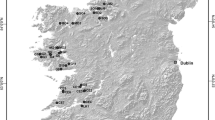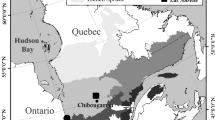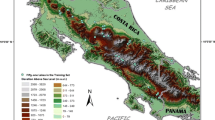Abstract
Chironomid assemblages from the uppermost sediments of 435 lakes spanning northern North America were compared to environmental parameters using direct gradient analysis. This large calibration set was merged from several previously developed regional datasets, and increases the number of modern analogues that are available for use for paleoenvironmental interpretations in this region. Air temperature explained the largest amount of variation in the chironomid assemblages with several other environmental factors accounting for statistical significant amounts of the remaining variance. A robust inference model for deriving past mean July air temperatures from subfossil chironomid assemblages was developed and applied to previously published paleoclimate reconstructions from the High-Arctic, Middle-Arctic, Boreal treeline, and Alpine regions of northern North America. The patterns of the temperature reconstructions from the combined dataset were generally similar to the original reconstructions, but with colder inferred temperatures reflecting the incorporation of a larger number of modern sites from colder climates in the combined dataset. This analysis demonstrated that the larger temperature gradient available in the new training set, when compared to the temperature gradients in the original training sets, provides a better estimation of chironomid-environment relationships. In particular, the optima and tolerances estimated using the larger, combined dataset should be more accurate, and therefore, improve midge-based paleoclimate reconstructions for northern North America. Despite the much larger spatial scale and greater associated environmental heterogeneity now incorporated in the combined dataset, this study suggests that in most cases the overarching constraint governing chironomid distributions in northern North America is temperature.






Similar content being viewed by others
References
Barley EM, Walker IR, Kurek J, Cwynar LC, Mathewes RW, Gajewski K, Finney BP (2006) A northwest North American training set: distribution of freshwater midges in relation to air temperature and lake depth. J Paleolimnol 36:295–314
Battarbee RW, Juggins S, Gasse F, Anderson NJ, Bennion H, Cameron NG (2000) European Diatom Database (EDDI). An information system for palaeoenvironmental reconstruction. In: Proceedings of the European climate science conference, pp 1–10
Birks HJB (1995) Quantitative paleoenvironmental reconstructions. In: Maddy D, Brew JS (eds) Statistical modeling of quaternary science data. Quaternary Research Association, London, pp 161–254
Birks HJB (1998) Numerical tools in paleolimnology-progress, potentialities, and problems. J Paleolimnol 20:307–322
Birks HJB, Birks HH (1980) Quaternary palaeoecology. Edward Arnold, London
Blanchet GF, Legendre P, Bocard D (2008) Forward selection of explanatory variables. Ecology 89:2623–2632
Brooks SJ, Birks HJB (2001) Chironomid-inferred air temperatures from Lateglacial and Holocene sites in north-west Europe: progress and problems. Quat Sci Rev 20:1723–1741
Bunbury J, Gajewski K (2009) Postglacial climates inferred from a lake at treeline, southwest Yukon Territory, Canada. Quat Sci Rev 28:354–369
Danks HV (2004) Seasonal adaptations in arctic insects. Integr Comp Biol 44:85–94
Eggermont H, Heiri O (2012) The chironomid-temperature relationship: expression in nature and palaeoenvironmental implications. Biol Rev 87:430–456
Engels S, Self AE, Luoto TP, Brooks SJ, Helmens KF (2014) A comparison of three Eurasian chironomid–climate calibration datasets on a W–E continentality gradient and the implications for quantitative temperature reconstructions. J Paleolimnol 51:529–547
Fortin M-C (2010) Post-glacial Chironomidae population responses to climate-driven variations in lake production in the Canadian Arctic Archipelago. Ph.D. thesis, Ottawa-Carleton Institute of Biology
Fortin M-C, Gajewski K (2010a) Postglacial environmental history of western Victoria Island, Canadian Arctic. Quat Sci Rev 29:2099–2110
Fortin M-C, Gajewski K (2010b) Holocene climate change and its effect on lake ecosystem production on Northern Victoria Island, Canadian Arctic. J Paleolimnol 43:219–234
Fortin M-C, Gajewski K (2011) Modern chironomid assemblages from the Canadian Arctic. GeoHydro, 2011. www.lpc.uottawa.ca/publications. Accessed on 27 Mar 2014
Fortin M-C, Gajewski K (2012) Potential problems with the use of gridded climate data in regional quantitative paleoenvironmental studies from data-poor regions. J Paleolimnol 48:641–650
Fritz SC, Anderson NJ (2013) The relative influences of climate and catchment processes on Holocene lake development in glaciated regions. J Paleolimnol 49:1–14
Gajewski K (1987) Climatic impacts on the vegetation of eastern North America for the past 2000 years. Vegetatio 68:179–190
Gajewski K (2015) Quantitative reconstruction of Holocene temperatures across the Canadian Arctic and Greenland. Global Planet Change 128:14–23
Gajewski K, Vance R, Sawada M, Fung M, Gignac LD, Halsey L, John J, Maisongrande P, Mandell P, Mudie P, Richard P, Sherrin A, Soroko J, Vitt D (2000) The climate of North America and adjacent ocean waters ca. 6 ka. Can J Earth Sci 37:661–681
Gajewski K, Lezine A-M, Vincens A, Delestan A, Sawada M, APD members (2002) Modern climate-vegetation-pollen relations in Africa and adjacent areas. Quat Sci Rev 21:1611–1631
Gajewski K, Bouchard G, Wilson S, Kurek J, Cwynar L (2005) Distribution of Chironomidae (Insecta: Diptera) head capsules in recent sediments of Canadian Arctic lakes. Hydrobiologia 549:131–143
Heiri O, Lotter AF (2001) Effect of low count sums on quantitative environmental reconstructions: an example using subfossil chironomids. J Paleolimnol 26:343–350
Heiri O, Brooks SJ, Birks HJB, Lotter AF (2011) A 274-lake calibration data-set and inference model for chironomid-based summer air temperature reconstruction in Europe. Quat Sci Rev 30:3445–3456
Heiri O, Brooks SJ, Renssen H, Bedford A, Hazekamp M, Ilyashuk B, et al (2014) Validation of climate model-inferred regional temperature change for late-glacial Europe. Nat Commun 5:1–7
Hill MO, Gauch HG (1980) Detrended correspondence analysis: an improved ordination technique. Vegetatio 42:47–58
Huisman J, Olff H, Fresco LFM (1993) A hierarchical set of models for species response analysis. J Veg Sci 4:37–46
Huntley B (2012) Reconstructing palaeoclimates from biological proxies: some often overlooked sources of uncertainty. Quat Sci Rev 31:1–16
Juggins S (2013) Quantitative reconstructions in palaeolimnology: new paradigm or sick science? Quat Sci Rev 64:20–32
Kaufman DS, Ager TA, Anderson NJ, Anderson PM, Andrews JT, Bartlein PJ, Brubaker LB, Coats LL, Cwynar LC, Duvall M, Dyke AS, Edwards ME, Eisner WR, Gajewski K, Geirsdóttir A, Hu FS, Jennings AE, Kaplan MR, Kerwin MW, Lozhkin AV, MacDonald GM, Miller GH, Mock CJ, Oswald WW, Otto-Bliesner BL, Porinchu DF, Rühland K, Smol JP, Steig EJ, Wolfe BB, PARCS working group (2004) Holocene thermal maximum in the western Arctic (0–180°W). Quat Sci Rev 23:529–560
Larocque I (2001) How many chironomid head capsules are enough? A statistical approach to determine sample size for palaeoclimatic reconstructions. Palaeogeogr Palaeoclimatol Palaeoecol 172:133–142
Larocque I, Hall RI (2003) Chironomids as quantitative indicators of mean July air temperature: validation by comparison with century-long meteorological records from northern Sweden. J Paleolimnol 29:475–493
Larocque I, Pienitz R, Rolland N (2006) Factors influencing the distribution of chironomids in lakes distributed along a latitudinal gradient in northwestern Québec, Canada. Can J Fish Aquat Sci 63:1286–1297
Lotter AF, Walker IR, Brooks SJ, Hofmann W (1999) An intercontinental comparison of chironomid palaeotemperature inference models: Europe vs North America. Quat Sci Rev 18:717–735
Luoto TP, Kaukolehto M, Weckström J, Korhola A, Väliranta M (2014) New evidence of warm early-Holocene summers in subarctic Finland based on an enhanced regional chironomid-based temperature calibration model. Quat Res 81:50–62
MacDonald GM, Porinchu DF, Rolland N, Kremenetsky K, Kaufman DS (2009) Paleolimnological evidence of the response of the central Canadian treeline zone to radiative forcing and hemispheric patterns of temperature change over the past 2000 years. J Paleolimnol 41:129–141
Medeiros AS, Quinlan R (2011) The distribution of the Chironomidae (Insecta: Diptera) along multiple environmental gradients in lakes and ponds of the eastern Canadian Arctic. Can J Fish Aquat Sci 68:1511–1527
Medeiros AS, Friel CE, Finkelstein SA, Quinlan R (2012) A high resolution multi-proxy record of pronounced recent environmental change at Baker Lake, Nunavut. J Paleolimnol 47:661–676
Medeiros AS, Taylor DJ, Couse M, Hall RI, Quinlan R, Wolfe BB (2014) Biologic and nutrient responses to catchment disturbance and warming in small lakes near the Alaskan tundra-taiga boundary. Holocene 24:1308–1319
Medeiros AS, Gajewski K, Vermaire JC, Porinchu D, Wolfe BB (2015) Detecting the influence of secondary gradients on paleo-temperature reconstructions. Quat Sci Rev. doi:10.1016/j.quascirev.2015.07.010
New M, Lister D, Hulme M, Makin I (2002) A high-resolution data set of surface climate over global land areas. Clim Res 21:1–25
Oksanen J, Kindt R, Legendre P (2009) The Vegan Package. http://vegan.r-forge.r-project.org/. Accessed 6 Sept 2013
Porinchu DF, Rolland N, Moser K (2009) Development of a chironomid-based air temperature inference model for the central Canadian Arctic. J Paleolimnol 41:349–368
Quinlan R, Smol J (2001) Setting minimum head capsule abundance and taxa deletion criteria in chironomid-based inference models. J Paleolimnol 26:327–342
Sawada M, Viau A, Vettoretti G, Peltier WR, Gajewski K (2004) Comparison of North-American pollen-based temperature and global lake-status with CCCma AGCM2 output at 6 ka. Quat Sci Rev 23:225–244
Self AE, Brooks SJ, Birks HJB, Nazarova L, Porinchu D, Odland A, Yang H, Jones VJ (2011) The distribution and abundance of chironomids in high-latitude Eurasian lakes with respect to temperature and continentality: development and application of new chironomid-based climate-inference models in northern Russia. Quat Sci Rev 30:1122–1141
Simpson GL (2007) Analogue methods in palaeoecology: using the analogue package. J Stat Softw 22:1–29
Simpson GL (2012) Analogue methods in palaeolimnology. Tracking environmental change using lake sediments. Springer, Netherlands, pp 495–522
Sullivan TJ, Charles DF (1994) The feasibility and utility of a paleolimnology/paleoclimate data cooperative for North America. J Paleolimnol 10:265–273
ter Braak CJF, Juggins S (1993) Weighted averaging partial least squares regression (WA-PLS): an improved method for reconstructing environmental variables from species assemblages. Hydrobiologia 269–270:485–502
ter Braak CJF, Looman CWN (1986) Weighted averaging, logistic regression and the Gaussian response model. Vegetatio 65:3–11
Viau A, Gajewski K, Sawada M, Bunbury J (2008) Low- and high-frequency climate variability in eastern Beringia during the past 25,000 years. Can J Earth Sci 45:1435–1453
Walker IR, Cwynar LC (2006) Midges and palaeotemperature reconstruction-the North American experience. Quat Sci Rev 25:1911–1925
Walker IR, Smol JP, Engstrom DR, Birks HJB (1991) An assessment of Chironomidae as quantitative indicators of past climatic change. Can J Fish Aquat Sci 48:975–987
Walker IR, Levesque AJ, Cwynar LC, Lotter AF (1997) An expanded surface-water palaeotemperature inference model for use with fossil midges from eastern Canada. J Paleolimnol 18:165–178
Webb T III, Bryson RA (1972) Late- and postglacial climatic change in the northern Midwest, USA: quantitative estimates derived from fossil pollen spectra by multivariate statistical analysis. Quat Res 2:70–115
Whitmore J, Gajewski K, Sawada M, Williams JW, Minckley T, Shuman B, Bartlein PJ, Webb T III, Viau AE, Shafer S, Anderson P, Brubaker L (2005) Modern pollen data from North America and Greenland for multi-scale paleoenvironmental applications. Quat Sci Rev 24:1828–1848
Wilson SE, Gajewski K (2004) Modern chironomid assemblages and their relationship to physical and chemical variables in southwest Yukon and northern British Columbia lakes. Arct Antarct Alp Res 36:446–455
Acknowledgments
This work was funded by grants from Natural Sciences and Engineering Research Council of Canada (NSERC), the Canadian Foundation for Climate and Atmospheric Sciences and the Canadian Climate Forum (CCF). Contributions from A.S.M. were made possible with support of the W. Garfield Weston Foundation. We are grateful to Gavin Simpson, who added functions to the R analogue package for our analysis, as well as the two anonymous reviewers who improved this manuscript.
Author information
Authors and Affiliations
Corresponding author
Electronic supplementary material
Below is the link to the electronic supplementary material.
Rights and permissions
About this article
Cite this article
Fortin, MC., Medeiros, A.S., Gajewski, K. et al. Chironomid-environment relations in northern North America. J Paleolimnol 54, 223–237 (2015). https://doi.org/10.1007/s10933-015-9848-0
Received:
Accepted:
Published:
Issue Date:
DOI: https://doi.org/10.1007/s10933-015-9848-0




